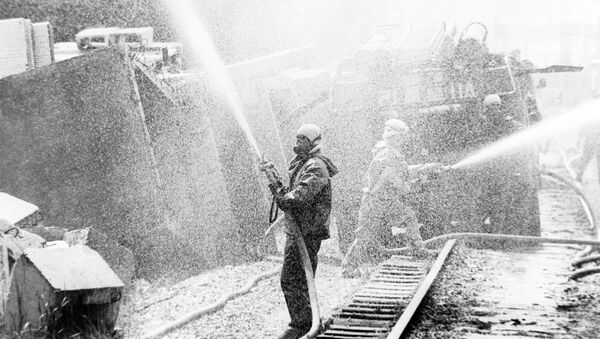Built in 1977, by 1986 the Chernobyl power plant had 4 working reactors. They were constantly upgraded and tested in various conditions to be able to withstand all sorts of anomalies – from cooling system breakdowns to power cuts.
On April 25 and 26, 1986, the staff carried out a series of emergency core cooling tests. The goal was to see how backup power generators would function if the engineers manually decrease the output of the reactor, moving the control rods and adjusting the flow of the coolant.
Alexander Akimov was chief of the night shift, and Leonid Toptunov- a young engineer – just three months out of college, was the operator responsible for the reactor's functioning.
Investigators believe that following a sequence of human errors, including the manual override of the reactor’s emergency functions, at 01:23 on April 26 there was a sharp spike in the reactor’s power production – 10 times its usual operational output. Fuel temperature rose uncontrollably causing steam to build up which was followed by two massive explosions.
However, there is an alternative opinion about the cause of the accident. In his interview posted on YouTube deputy chief engineer of Chernobyl power plant Anatoly Dyatlov said that it’s not human error, but the flawed design of the reactor that is to blame.
That disaster — it wasn’t something that was thought over. It could have happened during any other procedure and it’s not connected with the experiment. It happened during the experiment, but not because of it. The program of the experiment was well — planned, we spent a lot of time preparing for it.
The exact causes were very hard to establish and at some point investigators had to use mathematical simulation to reenact the chain of events.
Following the blasts flames engulfed Unit 4 building with radioactive steam and smoke rushing through the damaged roof of thereactor’s building and contaminating the atmosphere. Here’s a phone call recording of the first report from the scene. Minutes later dozens of fire crews from surrounding areas rushed into the inferno of the reactor building.
— Hello, is this VPCh-2 (Military-Fire Station)?
— Yes
— What is burning over there?
— It was an explosion… In the main building, between Units 3 and 4.
— Are there any people there?
— Yes
— Call the commanders!
Following the two blasts and the fire several of the plant’s staff members were reported missing. Their bodies were buried under tons of debris. Survivors, like chief of the night shift Alexander Akimov, stayed on the premises, trying to flood the reactor core with water, ignoring the deadly numbers on their dosimeters and not wearing any protective gear.
Thirty-one deaths are directly attributed to the accident. For most of those who were at the station on April 26 it was a fatal graveyard shift. Many, like Alexander Akimov and his young colleague Leonid Toptunov, as well as many of the local firefighters, died from radiation exposure within weeks.
But for thousands of people from surrounding communities – young and old, men, women and children who were sound asleep that night, unaware of what was going on in Chernobyl, the main part of the drama was about to unfold.
And the events that followed the April 26 disaster – a “Level 7 event” — the worst on the scale from 1 to 7 of nuclear accidents, changed the lives of these people forever.


